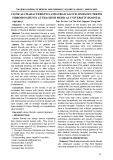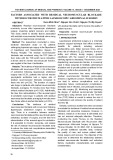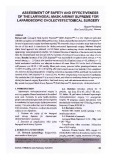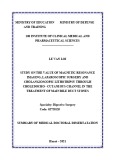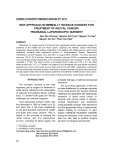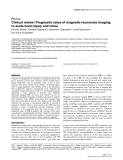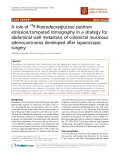MINISTRY OF EDUCATION MINISTRY OF DEFENSE
AND TRAINING
108 INSTITUTE OF CLINICAL MEDICAL AND
PHARMACEUTICAL SCIENCES
--------------------------------------------------------
LE VAN LOI
STUDY ON THE VALUE OF MAGNETIC RESONANCE
IMAGING, LAPAROSCOPIC SURGERY AND
CHOLANGIOSCOPIC LITHOTRIPSY THROUGH
CHOLEDOCHO - CUTANEOUS CHANNEL IN THE
TREATMENT OF MAIN BILE DUCT STONES
Specialty: Digestive Surgery
Code: 62720125
SUMMARY OF MEDICAL DOCTORAL DISSERTATATION
Hanoi – 2021
THIS STUDY WAS CONDUCTED AT 108 INSTITUTE OF
CLINICAL MEDICAL AND PHARMACEUTICAL SCIENCES
Scientific Supervisors:
1. A/Prof. Dr. Trieu Trieu Duong
2. Dr. Le Nguyen Khoi
Reviewer:
1.
2.
3.
The dissertation will be defended at thesis defense council at:
108 Institute of Clinical Medical and Pharmaceutical Sciences.
At..........day..........month........... 2021
Further reference to the thesis at:
1. Vietnam national library
2. 108 Institute of clinical medical and pharmaceutical
sciences library
1
INTRODUCTION
Gallstone disease is a common disease in Vietnam (3.32 - 6.11%
of the population) as well as in other countries around the world
which is associated with complicated disease progression, numerous
serious complications and even death if not treated promptly,
especially in case of intrahepatic gallstones.
To effectively treat gallstone disease, it is necessary to accurately
determine the location, the number of stones, and abnormal biliary
tract anatomy to choose the appropriate treatment method. Magnetic
resonance imaging is the most chosen method for gallstone
evaluation because of many advantages. However, there have not
been many studies on the imaging characteristics as well as the value
of magnetic resonance imaging in the diagnosis of gallstones in our
country. Therefore, further studies were needed to clarify the issue.
In Vietnam, laparoscopic surgery for gallstone disease started in
1992 at Cho Ray hospital. Along with the development of science
and technology, cholangioscopes as well as different methods of
lithotripsy and stone retrieval have been used. Consequently,
laparoscopic surgery combined with cholangioscopy has been widely
applied in the treatment of cholelithiasis. However, laparoscopic
surgery combined with cholangioscopy is still challenging due to
various causes including: difficult manipulation of the
cholangioscope due to increasing gap between the common bile duct
and the abdominal wall when the abdomen is inflated, difficulty in
maintaining the water pressure to dilate the bile ducts due to
continuous water leak at the site of the bile duct opening, spillage of
stone fragments and bile into the abdominal cavity leading to the
need of continous suctioning, prolonged operative time and potential
2
residual abscess formation. To overcome these above-mentioned
disadvantages, Vo Dai Dung et al had created a choledocho-
cutaneous channel through which cholangioscopic lithotripsy can be
performed.
However, there was still a lack of comprehensive research on this
issue in our country. Therefore, we decided to perform the thesis:
“Study on the value of magnetic resonance pancreato, laparoscopic
surgery and cholangioscopic lithotripsy through choledocho-
cutaneous channel in the treatment of main bile duct stones” with
two objectives:
1. To study the value of magnetic resonance imaging in the
the diagnosis of main bile duct stones.
2. To evaluate the results of laparoscopic surgery and
cholangioscopic lithotripsy through choledocho-cutaneous
channel in the treatment of main bile duct stones.
3
Chapter 1
LITERATURE REVIEW
1.1. The value of magnetic resonance imaging in the diagnosis of
cholelithiasis
1.1.1. In other countries
In developed countries, magnetic resonance cholangiopancreatography
(MRCP) has long been considered the most comprehensive method for
assessing biliary pathologies including cholelithiasis. There have been many
studies on imaging characteristics and values of MRCP in the evaluation of
cholelithiasis.
Many other studies compared other imaging methods including
ultrasound, CT scan, endoscopic ultrasound and endoscopic retrograde
cholangiopancreatography (ERCP) with MRCP. Some authors
concluded that MRCP can replace ERCP in the diagnosis of
choledochal stones.
The results from studies of other countries showed that the values of
MRCP in the diagnosis of cholelethiasis were as followed: sensitivity
91-100%, specificity 90-100%, positive predictive value 82 to 96 %,
and negative predictive value 96 - 100%.
1.1.2. In Vietnam
In Vietnam, there have been many studies on the chemical
composition of gallstones, on the pathogenesis of gallstones, and on the
values of different diagnostic imaging modalities in the diagnosis of
cholelithiasis including plain radiograph, ERCP, T tube cholangiogram,
ultrasound, intraoperative ultrasound.
Studies in Vietnam on the value of MRCP in the diagnosis of cholelithiasis
showed sensitivity of 92.5 - 100%, specificity of 83.3 - 90.9%, positive
predictive value of 96.2 - 98% and negative predictive value of 80 - 100%.
4
1.2. Results of laparoscopic surgery and cholangioscopic
lithotripsy through choledocho-cutaneous channel in the
treatment of main bile duct stones.
1.2.1. In other countries
Main bile duct Gallstones in Western countries are usually
secondary stones migrating from the gallbladder which are usually
small, in small number, often coexist with gallbladder stones, and are
located below the cystic duct without intrahepatic stones. Therefore,
transcystic stone removal is associated with resonable success rate of
50.4- 82.5%. In contrast, in Asian countries such as Hong Kong,
India, transcystic stone removal is not as common compared to
Western countries. There have been an increasing number of studies
on the application of laparoscopic surgery in the treatment of
gallstones with broadening indications However, there was no
research on laparoscopic treatment of main bile duct stones with the
use of cholangioscopic lithotripsy and choledocho-cutaneous
channel.
Overall results of studies using cholangioscopy to treat gallstones
around the world were as followed: success rates of 85 - 99%,
complication rate of 3.4 - 21.4% (most common complications were
infection and postoperative bile leakage). Bile leakage was the main
cause of death after surgery. Residual stone rate was 3.1 - 13%.
1.2.2. In Vietnam
The first cholecystectomy in Vietnam was performed at Cho Ray
Hospital in 1992 followed by a rapid increase in number of studies
on laparoscopic treatment of other diseases. In 1998, also at Cho Ray
Hospital, abdominal wall-lifting laparoscopic exploration of the
common bile duct to treat gallstones was first performed. In 1999,
5
Ho Chi Minh City University of Medicine and Pharmacy Hospital
performed conventional laparoscopic transcystic and
transcholedochal common bile duct exploration. In 2000, Viet Duc
Hospital and Hue Central Hospital started laparoscopic treatment
common bile duct stones.
Overall results of studies on laparoscopic surgery using
cholangioscopy to treat gallstones in Vietnam showed the following
results: success rate 86.49 - 100%, complication rate 3.9-11 21%
with the most common complications being infection, bile leakage
and residual abscess requiring reoperation.
In Vietnam, in order to overcome the above-mentioned limitations
of laparoscopic surgery combined with cholangioscopy, Le Nguyen
Khoi et al had created a choledocho-cutaneous channel through
which gallstones can be removed. However, Vo Dai Dung was the
first author who reported 43 cases of intrahepatic stones with or
without extrahepatic stones treated with laparoscopic surgery and
cholangioscopy through this channel with good results.
Therefore, cholangioscopy and especially the choledocho-
cutaneous channel plays an important role in laparoscopic treatment
of cholelithiasis by reducing the difficulties in controlling the
flexible cholangioscope as well as the rate of stones and bile spillage
into the abdominal cavity, reducing the operative time, increasing the
rate of stone clearance, and reducing abdominal cavity infection as
well as the postoperative residual abscess rates. In Vietnam, the
application of cholangioscopy and choledocho-cutaneous channel
was still limited. This study aimed to clarify the role of laparoscopic
surgery, cholangioscopy through the choledocho-cutaneous channel
in the treatment of cholelithiasis.
6
Chapter 2
SUBJECTS AND METHODS
2.1. SUBJECTS
2.1. Study subjects
Including 84 patients diagnosed with main bile duct stones,
treated with laparoscopic surgery combined with cholangioscopic
lithotripsy through the choledocho-cutaneous channel at Department
of Hepato-Biliary and Pancreatic Surgery of 108 Military Central
Hospital from June 2017 to March 2020
2.1.1. Inclusion criteria:
- Patients with a positive diagnosis of main bile duct stones
(confirmed in surgery), offered magnetic resonance
cholangiopancreatography (MRCP) and common bile duct diameter
of ≥ 8mm (on MRCP).
- Patients received laparoscopic surgery combined with
cholangioscopy through the chodedocho-cutaneous channel (LS-
CCC) as treatment.
- Patients agreed to participate in the study.
2.1.2. Exclusion criteria:
- Contraindications of general anesthesia needed for laparoscopic
surgery.
- Common bile duct diameter < 8mm on MRCP.
- Indications for hepatectomy e.g. biliary stenosis-induced focal
liver atrophy...
- Patients refused to participate in the study.
2.2. STUDY METHODS
2.2.1. Study design: a descriptive, propective study.
7
2.2.2. Study parameters
2.2.2.1. General characteristics of patients
* Clinical characteristics
- Age, gender.
- Clinical characteristics: pain, fever, jaundice, Charcot triads.
- History: number of previous ERCP, open common bile duct
(CBD) exploration, CBD exploration and cholecystectomy,
cholecystectomy, other abdominal operations.
- Comorbidities: cardiovascular diseases, pulmonary diseases,
diabetes, cirrhosism, etc…
* Paraclinical characteristics
Blood tests:
- Hematologic: white blood cell counts, neutrophil rate
- Biochemistry: total bilirubin, SGOT, SGPT.
- Coagulation panel: prothrombin ratio.
Hepatobiliary ultrasound:
- Biliary tract: common bile duct, right and left hepatic ducts sizes
- Bile duct stones: position, size, number
MRCP:
- Biliary tract: common bile duct, right and left hepatic ducts
sizes, stricture location.
- Bile duct stones: position, size, number
2.2.2.2. Value of MRCP in the diagnosis of cholelithiasis
- Stone position determined by MRCP
- Stone position determined intraoperatively
- Stone number determined by MRCP : small vs large number
- Stone number determined intraoperatively: small vs large number
8
- Biliary stricture location determined on MRCP and
intraoperatively.
- Determine the value of MRCP in the diagnosis of stone
position, number, biliary strictures by comparing with intraoperative
findings to calculate the Sensitivity, specificity, accuracy, positive
predictive value, negative predictive value using 2 x 2 tables.
2.2.2.3. Results of LS-CCC in the treatment of main bile duct
stones.
* Intraoperative characteristics
- Number of trocarts used: 4 trocarts, 5 trocarts
- Abdominal cavity condition: no adhesion, mild adhesion,
severe adhesion.
- Presence of bilary drainage: yes/no
- Cholecystectomy: yes/no
- Subhepatic drainage: yes/no
- Complications: hemorrhage, injuries of portal vein, hepatic
artery, duodenum, colon, etc…
- Operative time: counted from skin incision of the first trocart to
closure of the last trocart (minutes)
Placement of choledocho-cutaneous channel (CCC):
- Successful placement of CCC: yes/no.
- Placement time (mins)
- Difficulties: biliary injury, CCC dislodgement during stone
removal, stone and bile spillage into the abdominal cavity.
Cholangioscopy through CCC.
- Stone position, stone number (large vs small number).
- Biliary stricture: mild/moderate/severe stricture.
- Sphincter of Oddi: normal/stenosed
9
- Stone removal:
+ Methods: Mirrizi forcep, basket, lithotripsy.
+ Number of stones removed: small vs large number
+ Stone clearance: observed stone cleared vs retained
+ Retained stones: position, causes
- Time of stone removal: from the start to the end of stone
removal (mins).
* Early postoperative results
- Pain duration: based on postoperative analgesic use duration (days).
- Time to return of bowel function: from surgery to first flatus (days).
- Time to subhepatic drain removal: from surgery to drain removal (days).
- Hospital stay: from surgery to discharge (days).
- Early complications: hemorrhage, postoperative fluid collection,
intestinal fistula, biliary fistula, others…
Stone clearance results
- Ultrasound examination:
+ Stone clearance: yes/no
+ Retained stones: position
- Cholangiography:
+ Stone clearance: yes/no
+ Retained stones: position
- Cholangioscopy: yes/no.
Stone clearance was assessed by three modalities:
cholangioscopy, ultrasound, cholangiography. Stone clearance was
defined as no retained stones detected on all three modalities.
Factors associated with stone clearance:
- Stone position.
- Stone number.
10
- Biliary strictures. - Surgical history. * Follow-up results - Follow-up: yes/no - Follow-up types: regular/irregular - Time to follow-up: from surgery to follow-up day (days) - Ultrasound + Stone cleared/retained + Retained stoned position - Management of retained stones
+ Removal of biliary drain
+ Trans T-tube CBD exploration: number of procedures, suceess/failure of stone clearance. Results of surgery classification (criteria of the study group) - Good: + Successful placement of CCC + Stone clearance + No complications - Fair: + Successful placement of CCC + Retained stones or complications requiring only conservative therapies - Average: + Failure of placement of CCC + Reoperation due to complications - Bad: postoperative death 2.2.4. Data analysis - All data were encrypted and inputted into a computer and then processed using SPSS 20.0 software - The difference was considered statistically significant when p < 0.05 - Determine the values of MRCP in terms of the diagnosis of location, the number of stones of the CBD, RHD, LHD: sensitivity, specificity, accuracy, positive predictive value, negative predictive value (using 2x2 tables).
11
Chapter 3
RESULTS
3.1. Value of MRCP in the diagnosis of main bile duct stones
- Diagnosis of the position of extrahepatic stones: sensitivity: Se =
97.05%, specificity: Sp = 93.75%, accuracy: Acc = 96.42%, positive
predictive value : PPV = 98.51%, negative predictive value: NPV =
88.23%.
- Diagnosis of the position of right liver bile duct stones:
sensitivity: Se = 95.65%, specificity: Sp = 94.73%, accuracy: Acc =
95.23%, positive predictive value : PPV = 95.65%, negative
predictive value: NPV = 94.73%.
- Diagnosis of the position of left liver bile duct stones: sensitivity:
Se = 96.49%, specificity: Sp = 88.88%, accuracy: Acc = 94.04%,
positive predictive value : PPV = 94.82%, negative predictive value:
NPV = 92.30%
- Diagnosis of the number of main bile duct stones: sensitivity: Se
= 77.77%, specificity: Sp = 98.66%, accuracy: Acc = 96.42%,
positive predictive value: PPV = 87.50%, negative predictive value:
NPV = 97.36%.
- Diagnosis of biliary strictures: sensitivity: Se = 93.75%,
specificity: Sp = 100%, accuracy: Acc = 98.81%, positive predictive
value: PPV = 100%, negative predictive value: NPV = 98.55%
3.2. Results of LS-CCC in the treatment of main bile duct stones.
3.2.1. Intraoperative findings
- In 95.2 % of patients 4 trocarts were used and in only 4.8% of
patients 5 trocarts were used.
- 41.7% of patients with history of abdominal operations having
adhesion, in which 35.7% of patients had severe adhesion.
12
* Placement of CCC:
- Success rate: 100%
- Placement time: 5.05 ± 2.47 mins
- Bile duct injury during placement: 02 patients (2.4%)
- Channel dislodgement during stone removal: 03 patients (3.6%)
- There were no cases with stone or bile spillage into the
abdominal cavity.
* Complications:
01(1.2%) patient with colon seromuscular injury and repaired
laparoscopically.
01(1.2%) patient with biliary hemorrhage after bilary dilatation
using stone, treated with warm saline irrigation.
* Operative time:
Mean: 121.85 ± 30.47 (mins)
* Biliary strictures:
Mild - 1 patient (1.2%), moderate – 4 patients (4.8%), severe 11
patients (13.1%)
* Stone removal results:
Observed stone clearance by cholangioscopy: 69 patients (82.1%)
Observed retained stones by cholangioscopy: 15 patients
(17.9%)
* Causes of retained stones observed by cholangioscopy:
Biliary strictures: 15/15 (100%) patients
* Time of stone removal:
Mean: 52.50 ± 22.84 mins
3.2.2. Early results
- Postoperative pain duration: 1.9 ± 0.53 days (1- 4 days)
- Time to return of bowel function: 2.17 ± 0.82 days (1- 4 days)
13
- Postoperative hospital stay: 9.48 ± 3.609 days (4 - 24 days)
- Postoperative complications: 8 patients (9.6%): including
intestinal fistula – 1 patient (1.2%), biliary fistula - 1 patient (1.2%).
Table 3.24. Stone removal results
Stone clearance Patients (n = 84) Rate (%)
Cholangioscopy 69 82.1
Ultrasound 46 54.8
Cholangiography 72 85.7
Total clearance 46 54.8
* Factors related to postoperative stone clearance: stone position,
number, biliary stricture and no association with surgical history
3.2.3. Follow-up results
* Mean time to follow-up: 31.77 ± 11.23 (days)
* Ultrasound results:
Stone clearance: 58 patients (69%)
Stone retained: 26 patients (31%)
* Management after follow-up:
Biliary drain removal during follow-up: 58 patients (69%)
Admission for trans T-tube CBD exploration: 26 patients (31%)
Trans T-tube CBD exploration one time: 22 patients = 26.2 %
Stone retained after treatment: 4 patients = 4.8%
Stone clearance after treatment: 80 patients = 95.2%
3.2.4. Treatment result classification
Good: 50 (59.5%) patients
Fair: 34 (40.5%) patients
14
Chapter 4
DISCUSSION
4.1. Values of MRCP in the diagnosis of main bile duct stones
4.1.1. Stone position
* Extrahepatic main bile duct stone position
The diagnosis of extrahepatic main bile duct stone position by
MRCP had the sensitivity (Se) of 97.5%, the specificity (Sp) of
93.75%, the accuracy (ACC) of 96.42%, the positive predictive value
(PPV) of 98.5%, and the negative predictive value (NPV) of 88.23%
(Table 3.13). This result is equivalent to the study of Pham Hong
Lien, Nguyen Viet Thanh.
* Right intrahepatic bile duct stone position
The diagnosis of right intrahepatic bile duct stone position by
MRCP had the sensitivity (Se) of 95.65%, the specificity (Sp) of
94.73%, the accuracy (Acc) of 95.23%, the positive predictive value
(PPV) of 95.65%, the negative predictive value (NPV) of 94.73%
(Table 3.14). Nguyen Huu Thinh, Park et al. studied the value of
MRCP in the diagnosis of stone position by liver segments showing
similar results. Nguyen Viet Thanh’s study also showed similar
results: sensitivity (Se) 90.9%, specificity (Sp) 91.2%, accuracy
(Acc) 91.1%, positive predictive value (PPV) 81.6%, negative
predictive value (NPV) 95.9%.
* Left intrahepatic bile duct stone position
The diagnosis of left intrahepatic bile duct stone position by
MRCP had the sensitivity (Se) of 96.49%, the specificity (Sp) of
88.88%, the accuracy (ACC) of 94.04% , the positive predictive
value (PPV) of 94.82%, the negative predictive value (NPV) of
92.30%. This result is equivalent to the study of Nguyen Viet Thanh,
15
with the sensitivity (Se) of 100%, the specificity (Sp) of 93.2%, the
accuracy (ACC) of 96. 5%, the positive predictive value (PPV) of
93.5%, and negative predictive value (NPV) of 100%. This result is
also consistent with the study of Nguyen Huu Thinh and Park on
determining the diagnostic value of MRCP by liver segments.
4.1.2. Stone number
The diagnosis of the number of stones by MRCP in the study had
the sensitivity of 77.8%, the specificity of 98.7%, the accuracy of
96.4%, the positive predictive value of 87.5%, and the negative
predictive value of 97.4%. The research results are inferior compared
to Pham Hong Lien's research with MRCP provided accurate
diagnosis of the number of stones (100%).
Study also showed that MRCP also had some limitations including
inability to assess stone migration from the time of imaging to surgery,
high cost, requirement of interpretation by specialists which is only
feasible in major hospitals.
4.1.3. The values of MRCP in the evaluation of biliary strictures
The diagnosis of biliary strictures by MRCP in the study had the
sensitivity of 93.75%, the specificity of 100%, the accuracy of 98.81%,
the positive predictive value of 100%, the negative predictive value of
98.55%. False negative cases were mostly patients with a history of
recurrent cholangitis or biliary tract intervention. Recurrent
inflammation leads to secondary biliary fibrosis causing non-dilation of
post-obstruction bile duct segments and limiting the ability to locate the
strictures. This results are equivalent to the study of Nguyen Huu Thinh
in which the diagnosis of biliary stenosis had the sensitivity and
specificity of 83.3% and 97.1% in the left lateral section, 100% and
100% in the anterior section, 100% and 97.9% in the posterior section.
16
4.2. Results of LS-CCC in the treatment of main bile duct stones.
4.2.1. Intraoperative results
* Trocart insertion
In 80 cases (95.2%), 4 trocarts were used and in 04 patients (4.8%) 5
trocarts were used. In our study, the fourth trocart (10mm) was placed
last, at the projection point of the intended CBD opening to the anterior
abdominal wall. In contrary, other authors often use a 5mm trocar at the
4th trocar position. We used 10mm trocar at the fourth trocar position
because the choledocho-cutaneous channel and eventually the T-tube
drainage would be inserted through this point.
* Placement of choledocho-cutaneous channel.
Success rate of CCC placement
Since this study focused on evaluating the results of using
cholangioscopic stone removal through the CCC, the operation was
considered successful only the stones were removed through a
successfully placed channel. Failure was defined as inability to place
the channel or inability to remove the stones through the channel and
alternative methods were to be used. Placement of the channel was
accomplished in all 84 patients (100%).
Channel placement time
The mean channel placement time was 5.05 ± 2.47 minutes,
ranging from 2 minutes to 15 minutes. The case with longest
placement time was due to the thin bile ducts wall resulting in tearing
the bile duct which required suture repair and replacement.
Difficulties in channel placement
There were 02 patients (2.4%) complicated with biliary tract
injury during channel placement due to thin bile duct wall requiring
suture repair and successful replacement. There were 03 patients
17
(3.6%) in whom the channel was dislodged from the common bile
duct because the diameter of stone was greater than that of the
channel. There were no cases with stone or bile spillage into the
abdomen. We maintained the abdominal pressure of 6-8 mmHg so
that if the channel was not tightly fit, the gas would push the water
out and alert the operating surgeon to stop the procedure and replace
the channel.
* Complications
There were 02 patients (2.4%) having intraoperative
complications, including: 01 patient with seromuscular injury of the
colon resulting from adhesiolysis of the adhesion between the colon
and the liver. The injury was successfully repaired by laparoscopic
suturing. This was the case with history of open CBD exploration
once. The patient recovered uneventfully and was discharged home
on the 8th day. 01 patient had biliary hemorrhage due to bile duct
dilatation with stones treated by warm salt saline irrigation.
* Operative time
The mean operative time was 121.85 ± 30.47 mins, ranging from
70 to 200 mins. Our mean operative time is 68 mins longer than that
of Tran Manh Hung’s study which only treated CBD stones. Our
results were equivalent to the study of Nguyen Hoang Bac (117
mins), and Berthou (124 mins). However, our result was 187 minutes
shorter than Lee H.M, Zhu. J (179.7 mins), Nguyen Khac Duc (150
mins), Su Quoc Khoi (139 mins), and Vu Duc Thu (133.6 ± 46.63
mins).
* Cholangioscopy through the choledocho-cutaneous channel
Stone removal using Mirrizi forcep
18
After CBD opening, if there were large CBD stones which could
be easily removed, we would withdraw the 10mm trocart in the right
subcostal region and use Mirizzi forcep to to remove the stones
followed by CCC placement through the same port site.
Stone removal using basket
The rate of basket use in our study was 100% higher than in
previous studies. Due to the large diameter of the CBD (mostly>
10mm (71.4%)), there were no significant differences between
laparoscopic and open surgery in removal of large stones.
Lithotripsy techniques
If the stone size was ≥ 10mm which exceeded the channel size or
if gallstones were tightly fit the bile duct lumen and could not be
removed by basket. electro-hydraulic lithotripsy was used to
fragment the stones before being retrieved.
Flushing technique
In addition to continuous irrigation through the channel of the
cholangioscope, when stones accumulated too much in the bile ducts,
we withdrew the cholangioscope and inserted a 12-14F plastic tube
to flush the bile ducts similar to open surgery.
Biliary strictures
There were 16 patients (19.1%) with biliary strictures, of which
11 patients (13.1%) having severe strictures, 14 patients (16.7%)
having 01 stricture, 2 patients (2.4%) ) has 2 strictures. Our rate of
biliary strictures is lower than that of Vo Dai Dung with 13/43
patients having strictures (30.23%). These strictures were dilated
with stones during surgery and with a balloon or dilatation tube using
the trans T-tube approach.
19
Results of cholangioscopic stone removal
The study showed 69 patients (82.1%) with stone clearance
observed by cholangioscopy. However, only 46 patients (54.8%) had
stone clearance confirmed after surgery. The results of the study are
higher than the results of Vo Dai Dung: with intraoperative stone
clearance rate of 39.5% and the postoperative stone clearance rate of
30.23 %.
The cause of retained stones observed by cholangioscopy was
bile duct strictures in 15 patients (17.9%). In case of inability to clear
the stone after stricture dilatation with stones during surgery, trans T-
tube stone removal was used during follow-up.
The mean time of stone removal in the study was 52.50 ± 22.84
(mins), ranging from 10 minutes to 125 minutes. Stone removal time
was significantly longer for group of patient with larger number of
stones(p = 0.0032). Stone removal time directly affected operative
time.
4.2.2. Early results
* Postoperative hospital stay
The mean postoperative hospital stay was 9.48 (days). Our
research results were equivalent to those of Vo Dai Dung (9.65
days), Su Quoc Khoi (10.5 ± 2.7 days).
* Early complications
There were 8 patients (9.6%) having early complications. The
result is higher than that of Nguyen Khac Duc (3.9%), Su Quoc Khoi
(5.8%), Vo Dai Dung (4.7%).
03 patients had subhepatic fluid collection after surgery without
any symptoms, and all were incidentally detected only during
20
postoperative ultrasound examination which required no further
intervention.
There was 01 patient (1.2%) having postoperative intestinal
fistula detected on the 4th day after surgery. The volume of the
fistula through the drainage was approximately 100 ml/day. The
patient was treated with Nil by mouth and total parenteral nutrition.
The fistula volume gradually decreased and complete resolution was
noted on the 18th day. This patient had a history of one surgery for
biliary stones. Excessive adhesiolysis or electrocautery caused injury to
the gastrointestinal tract which was unrecognized by the surgeon until day
4.
There was 01 patient (1.2%) with suspected bile leakage having
wet,yellowish wound dressing of the T-tube exit site on the 5th day
after surgery but spontaneously resolving on the 12th day after
surgery. This case did not fulfill all the criteria of bile leakage.
* Stone clearance
Stone clearance rate
The stone clearance rate is the most important indicator of the
treatment results for cholelithiasis. Some authors used the
observations by cholangioscopy to define the postoperative stone
clearance [3], [110]. Our study assess stone clearance using all 3
modalities: cholangioscopy, cholangiography and ultrasound. The
postoperative stone clearance rate of our study was 54.8%.
* Factors related to stone clearance rate
Stone position: The rate of stone clearance was significantly
associated with stone position with p = 0.002. This is similar to the
results of Vo Dai Dung in which stone clearance rate was statistically
21
significantly correlated to stone position with p = 0.01 (Chi - square
tests) [73].
Stone number: the correlation between postoperative stone
clearance rate and the number of stones was statistically significant
with p = 0.029. Our research results are equivalent to that of Vo Dai
Dung, in which postoperative stone clearance rate and the number of
stones was statistically significantly correlated with p = 0.03 (Chi -
square tests).
Biliary strictures: the study showed that there was no patient
achieving stone clearance after surgery in the group having biliary
strictures. Biliary stricture was associated with postoperative stone
clearance and the association was statistical significance with p =
0.00. Vo Dai Dung's study showed similar results with no stone
clearance in biliary stricture group (p = 0.004).
Surgical history: postoperative stone clearance rate and surgical
history were not statistically significantly correlated to each other (p
= 0.711). This result is equivalent to that of Vo Dai Dung in which
the correlation between postoperative stone clearance and surgical
history was not statistically significant (p = 0.29).
4.2.3. Follow-up results
Using ultrasound, there were 58 patients (69%) with stone
clearance at follow-up, which was higher than the postoperative rate
(46 patients with stone clearance). The reason for higher stone
clearance rate was retained stone fragments incompletely flushed
during surgery detected on immediate postoperative ultrasound
which were eventually cleared by self-flushing of the T-tube under
guidance at home. In cases of complete stone clearance on follow-up
ultrasound, the T-tube was withdrawn and patients were discharged
22
home on the same day. There were 26 patients (31%) with retained
stones detected on ultrasound, in which the majority of retained
stones were located in the right liver 11/26 (42.3%) patients. These
patients were admitted for lithotripsy through the T-tube tunnel.
There were 22 patients (26.2%) achieving stone clearance after one
time lithotripsy through the T-tube tunnel, 7 out of 11 patients with
severe bile duct strictures which were dilated with stones and
eventually achieving stone clearance. There were 4 patients (4.8%)
in which we were unable to remove all the stones even after stricture
dilatation. We defined those cases as post-treatment stone retention.
Finally, the stone clearance rate of our study was 95.2%.
4.2.4. Overall treatment result classification
The overall treatment result of the study was classified as good
in 59.5% and fair in 40.5%, which was an encouraging result. It is
very difficult to compare with studies done in Vietnam because the
inclusion criteria was different. Most of the previous studies selected
patients with extra-hepatic main bile duct stones. Nguyen Khac Duc
studied on laparoscopic treatment of extra-hepatic cholelithiasis with
good results in 86.7% and average results in 9.4%.
23
CONCLUSION
Through the study of 84 patients who received laparoscopic
surgery combined with cholangioscopy through choledocho-
cutaneous channel to treat main bile duct stones at 108 Central
Military Hospital, from July 2017 to March 2020, we had the
following conclusions:
1. Value of MRI in the diagnosis of main bile duct stones
The sensitivity, specificity, accuracy, positive predictive value,
negative predictive value of MRI in the diagnosis of stone position
were, respectively: 97.05%; 93.75%; 96.42%; 98.51%; 88.23% for
main extra-hepatic bile duct, 95.65%; 94.73%; 95.23%; 95.65%;
94.73% for right intrahepatic bile ducts, 96.49%; 88.98%; 94.04%;
94.82%, 92.30% for left intrahepatic bile ducts.
The sensitivity, specificity, accuracy, positive predictive value,
negative predictive value of MRI in the diagnosis of the number of
stones were: 77.77%; 98.66%; 96.42%; 87.50%; 97.36%,
respectively.
The sensitivity, specificity, accuracy, positive predictive value,
negative predictive value of MRI in the diagnosis of biliary stenosis
were 93.75%; 100%; 98.81%; 100%; 98.55%, respectively
2. Results of laparoscopic surgery combined with cholangioscopy
through the choledocho-cutaneous channel in the treatment of
main bile duct stones.
* Intraoperative results:
Placement of channel: 100% success, insertion time: 5.05 ± 2.47
minutes (2 - 15 minutes), biliary tract injury during insertion 2.4%,
channel dislodgement during stone removal 3.6%, no cases of bile
and stones spillage into the abdomen
24
Stone removal time: 52.50 ± 22.84 minutes (10 - 125 minutes)
Operative time: 121.85 ± 30.47 minutes (70 - 200 minutes)
Complications: 2.4%
* Early results:
Postoperative pain duration: 1.9 ± 0.53 days (1- 4 days)
Postoperative time to return of bowel function: 2.17 ± 0.82 days
(1- 4 days)
Postoperative hospital stay: 9.48 ± 3,609 days (4 - 24 days)
Postoperative stone clearance rate: 54.8%, postoperative stone
clearance rate was correlated to stone postion, number of stones, bile
duct stricture and not correlated to surgical history
Early complications: 9.6%
* Follow-up results:
Mean follow-up time: 31.77 ± 11.23 (day)
T-tube withdrawn at follow-up 58 patients (69%), hospitalization
for lithotripsy through Kehr tunnel: 26 patients (31%), stone
clearance after one time Kehr tunnel lithotripsy: 22 patients (26.2%)
Post-treatment stone retention: 4 patients (4.8%), final stone
clearance : 80 patients (95.2%)
Overall result: good 59.5%, fair 40.5%
25
RECOMMENDATIONS
Through the research process, we have the following
recommendations:
1. Further study with a larger number of patients, longer follow-up
time is required.
2. It is necessary to be equipped with a 3-mm cholangioscopy in
cases of biliary strictures which can not be approached using a 5.2
mm cholangioscopy.
LIST OF RELATED PUBLICATIONS
1. Le Van Loi, Trieu Trieu Duong, Le Nguyen Khoi (2020),
“Results of laparoscopic surgery combined with
cholangioscopy through choledocho-cutaneosu channel”,
Journal of 108 - Clinical medicine and pharmacy, (15), 6,
pp. 77 - 83.
2. Le Van Loi, Trieu Trieu Duong, Le Nguyen Khoi (2020),
“Values of magnetic resonance imaging in the diagnosis of
main bile duct stones”, Journal of 108 - Clinical medicine
and pharmacy, (15), 6, pp. 147 - 153.

